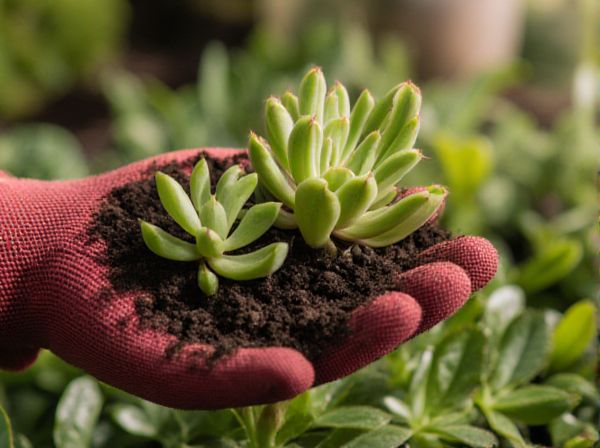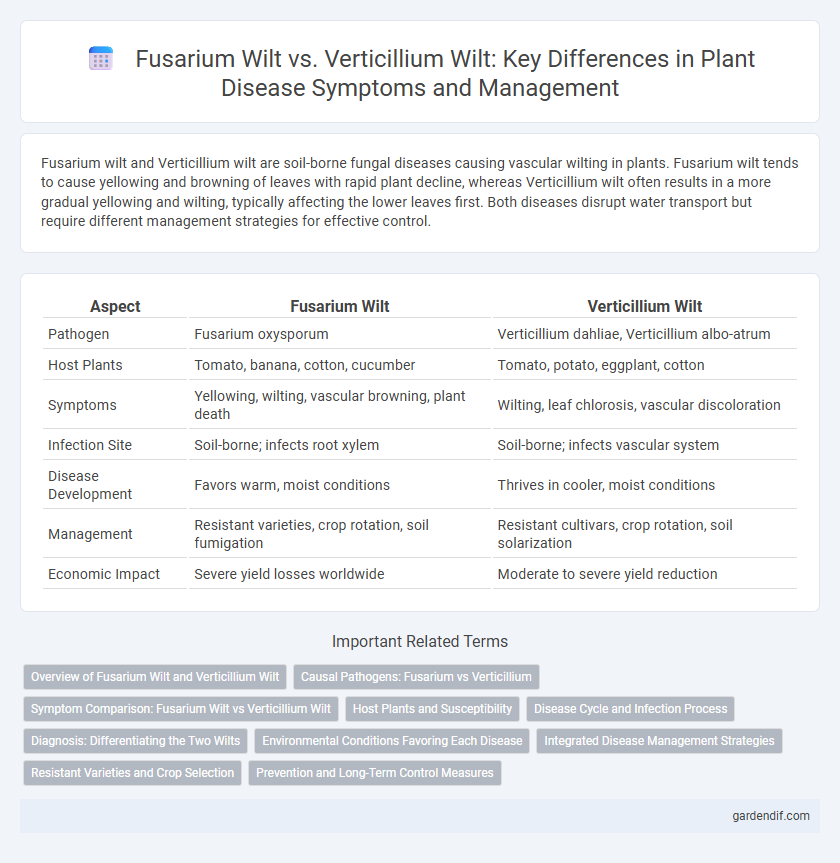
Fusarium wilt vs Verticillium wilt Illustration
Fusarium wilt and Verticillium wilt are soil-borne fungal diseases causing vascular wilting in plants. Fusarium wilt tends to cause yellowing and browning of leaves with rapid plant decline, whereas Verticillium wilt often results in a more gradual yellowing and wilting, typically affecting the lower leaves first. Both diseases disrupt water transport but require different management strategies for effective control.
Table of Comparison
| Aspect | Fusarium Wilt | Verticillium Wilt |
|---|---|---|
| Pathogen | Fusarium oxysporum | Verticillium dahliae, Verticillium albo-atrum |
| Host Plants | Tomato, banana, cotton, cucumber | Tomato, potato, eggplant, cotton |
| Symptoms | Yellowing, wilting, vascular browning, plant death | Wilting, leaf chlorosis, vascular discoloration |
| Infection Site | Soil-borne; infects root xylem | Soil-borne; infects vascular system |
| Disease Development | Favors warm, moist conditions | Thrives in cooler, moist conditions |
| Management | Resistant varieties, crop rotation, soil fumigation | Resistant cultivars, crop rotation, soil solarization |
| Economic Impact | Severe yield losses worldwide | Moderate to severe yield reduction |
Overview of Fusarium Wilt and Verticillium Wilt
Fusarium wilt is a soil-borne fungal disease caused by Fusarium oxysporum species, leading to vascular wilt and yellowing in over 100 plant species, particularly affecting tomatoes, bananas, and cotton. Verticillium wilt, caused by Verticillium dahliae and Verticillium albo-atrum, also targets the plant vascular system, causing leaf chlorosis, wilting, and stunted growth across a wide range of crops including potatoes, cotton, and olives. Both diseases persist in soil, survive in plant debris, and pose significant threats to agricultural productivity due to their ability to colonize xylem vessels and disrupt water transport.
Causal Pathogens: Fusarium vs Verticillium
Fusarium wilt is caused by Fusarium oxysporum, a soil-borne fungal pathogen that invades plant roots and disrupts vascular tissues, leading to wilting and yellowing. Verticillium wilt results from infection by Verticillium dahliae or Verticillium albo-atrum, fungi that colonize xylem vessels, causing vessel clogging and systemic plant decline. Both pathogens persist in soil and plant debris, but Fusarium produces chlamydospores while Verticillium forms microsclerotia, influencing their survival and infection strategies.
Symptom Comparison: Fusarium Wilt vs Verticillium Wilt
Fusarium wilt symptoms include yellowing leaves, vascular discoloration, and wilting that typically begins on one side of the plant and progresses asymmetrically. Verticillium wilt causes chlorosis, necrosis, and vascular browning, often affecting both sides of the plant more uniformly and leading to leaf curl and defoliation. Both diseases impair water transport by colonizing xylem vessels but differ in the pattern and severity of symptom development.
Host Plants and Susceptibility
Fusarium wilt primarily targets solanaceous crops such as tomatoes, peppers, and eggplants, showing high susceptibility in these hosts due to the pathogen's ability to invade vascular tissue and disrupt water transport. Verticillium wilt affects a broader range of plants, including cotton, lettuce, and many woody ornamentals, often exhibiting variable susceptibility influenced by host species and environmental conditions. Managing resistance through cultivar selection is critical, as both soil-borne fungi persist in the soil and cause similar wilting symptoms but differ in host specificity and pathogen biology.
Disease Cycle and Infection Process
Fusarium wilt and Verticillium wilt both involve soilborne fungal pathogens that infect plants through root penetration, but Fusarium oxysporum produces chlamydospores enabling long-term soil survival, while Verticillium dahliae forms microsclerotia for persistence. The infection process begins when fungal spores germinate in the rhizosphere, followed by fungal hyphae invading root cortical cells and subsequently colonizing xylem vessels, leading to vascular blockage and wilting symptoms. Disease cycles of both pathogens rely on soilborne inoculum that infects susceptible host plants, with Fusarium wilt often showing a monocyclic pattern and Verticillium wilt exhibiting a polycyclic cycle through repeated secondary infection.
Diagnosis: Differentiating the Two Wilts
Fusarium wilt can be diagnosed by observing yellowing and wilting that starts on one side of the plant, with brown vascular discoloration inside the stem, whereas Verticillium wilt causes more uniform yellowing and wilting with dark, irregular vascular streaks. Laboratory confirmation using fungal cultures or molecular PCR techniques helps differentiate Fusarium oxysporum from Verticillium dahliae, the causative pathogens. Accurate diagnosis is essential for effective management, as Fusarium wilt often requires crop rotation and resistant varieties, while Verticillium wilt emphasizes soil fumigation and sanitation.
Environmental Conditions Favoring Each Disease
Fusarium wilt thrives in warm soil temperatures between 77degF and 86degF and is favored by sandy, well-drained soils with low organic matter. Verticillium wilt prefers cooler conditions, surviving in a wide range of soil types but proliferating in moist, heavier soils with temperatures around 60degF to 70degF. Both pathogens persist in soil and crop debris, but distinct environmental conditions influence their infection rates and severity in crops like tomatoes and cotton.
Integrated Disease Management Strategies
Integrated disease management strategies for Fusarium wilt and Verticillium wilt emphasize crop rotation with non-host species, use of resistant cultivars, and soil solarization to reduce pathogen load. Biological control agents such as Trichoderma spp. and Bacillus subtilis demonstrate efficacy by suppressing fungal populations in the rhizosphere. Implementing precise irrigation management and balanced fertilization further minimizes plant stress, enhancing overall resistance against these soilborne vascular wilt pathogens.
Resistant Varieties and Crop Selection
Resistant varieties for Fusarium wilt often include specific tomato cultivars such as 'Celebrity' and 'Better Boy,' which carry resistance genes like I, Fw, or Fol races. Verticillium wilt-resistant cultivars include 'VFN' varieties that combine resistance to Verticillium, Fusarium, and Nematodes, suitable for crops like eggplant or cotton. Crop rotation and selection of disease-resistant species minimize inoculum buildup and improve management of both Fusarium and Verticillium wilt in agricultural systems.
Prevention and Long-Term Control Measures
Fusarium wilt prevention relies on crop rotation with non-host plants and using resistant cultivars specific to Fusarium oxysporum races, while soil solarization helps reduce pathogen load in infested fields. Verticillium wilt management emphasizes sanitation through removal of infected plant debris and application of organic amendments to promote antagonistic microbial activity in soil. Long-term control for both diseases benefits from integrated practices including maintaining soil health, careful irrigation management to prevent moisture stress, and monitoring for early disease symptoms to limit spread.
Fusarium wilt vs Verticillium wilt Infographic

 gardendif.com
gardendif.com